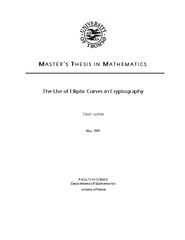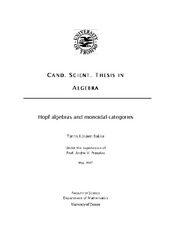Blar i utgivelsesdato Institutt for matematikk og statistikk
Viser treff 21-40 av 389
-
Invariants of pseudogroup actions: Homological methods and Finiteness theorem
(Working paper; Arbeidsnotat, 2005-12-07)We study the equivalence problem of submanifolds with respect to a transitive pseudogroup action. The corresponding differential invariants are determined via formal theory and lead to the notions of l-variants and l-covariants, even in the case of non-integrable pseudogroup. Their calculation is based on the cohomological machinery: We introduce a complex for covariants, define their cohomology ... -
Vanishing of the entropy pseudonorm for certain integrable systems
(Journal article; Tidsskriftartikkel; Peer reviewed, 2006) -
A simple criterion for the m-cyclicity of the group of rational points on an elliptic curve defined over a finite field
(Journal article; Tidsskriftartikkel; Peer reviewed, 2006-02)We give a simple criterion for the cyclicity of the m-torsion subgroup of the group of rational points on an elliptic curve defined over a finite field of characteristic larger than 3 for m = 2, 3, 4, 6, 12. -
Nature reserves as a bioeconomic management tool. A simplified modeling approach
(Working paper; Arbeidsnotat, 2006-02)This paper demonstrates analytically how a nature reserve may protect the total population, realize maximum sustainable yield (MSY), maximum economic yield (MEY) and consumer surplus (CS) and how this depends on biological growth, migration, reserve size and economic parameters. The pre-reserve population is assumed to follow the logistic growth law and two post-reserve growth models are discussed. ... -
Abelian equations and rank problems for planar webs
(Journal article; Tidsskriftartikkel; Peer reviewed, 2006-05-04)We find an invariant characterization of planar webs of maximum rank. For 4-webs, we prove that a planar 4-web is of maximum rank three if and only if it is linearizable and its curvature vanishes. This result leads to the direct web-theoretical proof of the Poincar´e’s theorem: a planar 4- web of maximum rank is linearizable. We also find an invariant intrinsic characterization of planar 4-webs ... -
Dimension of the solutions space of PDEs
(Conference object; Konferansebidrag, 2006-10-26)We discuss the dimensional characterization of the solutions space of a formally integrable system of partial differential equations and provide certain formulas for calculations of these dimensional quantities. -
Bayesian modeling and significant features exploration in wavelet power spectra
(Journal article; Tidsskriftartikkel; Peer reviewed, 2007) -
Statistical analysis of CGPS time series
(Master thesis; Mastergradsoppgave, 2007)All points on the surface of the Earth are moving. To define the velocity of a given point, we can place a GPS receiver there and measure the coordinates every day. After collecting enough data, we can generate a time series of three coordinates, North, East and Height directions. The most used technique to determine such displacements, is the linear model. The main objective of this thesis ... -
The use of elliptic curves in cryptography
(Master thesis; Mastergradsoppgave, 2007-06)The use of elliptic curves in cryptography was suggested independently by Neal Koblitz and Victor Miller in 1985. Being a relatively new field, there is still a lot of ongoing research on the subject, but elliptic curve cryptography, or ECC for short, has already been implemented in real-life applications. Its strength was proved in 2003 when the U.S. National Security Agency adopted ECC for protecting ... -
Hopf algebras and monoidal categories
(Master thesis; Mastergradsoppgave, 2007-06-14)In this thesis we study the correspondence between categorical notions and bialgebra notions, and make a kind of dictionary and grammar book for translation between these notions. We will show how to obtain an antipode, and how to define braidings and quantizations. The construction is done in two ways. First we use the properties of a bialgebra to define a monoidal structure on (co)modules over ... -
Invariant characterization of Liouville metrics and polynomial integrals
(Journal article; Tidsskriftartikkel; Peer reviewed, 2007-09-04)A criterion in terms of differential invariants for a metric on a surface to be Liouville is established. Moreover, in this paper we completely solve in invariant terms the local mobility problem of a 2D metric, considered by Darboux: How many quadratic in momenta integrals does the geodesic flow of a given metric possess? The method is also applied to recognition of other polynomial integrals ... -
Invariants and submanifolds in almost complex geometry
(Chapter; Bokkapittel, 2007-12-20)In this paper we describe the algebra of differential invariants for GL(n,C)-structures. This leads to classification of almost complex structures of general positions. The invariants are applied to the existence problem of higher-dimensional pseudoholomorphic submanifolds. -
Differential invariants of the motion group actions
(Working paper; Arbeidsnotat, 2007-12-20)Differential invariants of a (pseudo)group action can vary when restricted to invariant submanifolds (differential equations). The algebra is still governed by the Lie-Tresse theorem, but may change a lot. We describe in details the case of the motion group O(n) ⋉ R<sup>n</sup> acting on the full (unconstraint) jet-space as well as on some invariant equations. -
Symmetry approaches for reductions of PDEs, differential constraints and Lagrange-Charpit method
(Journal article; Tidsskriftartikkel; Peer reviewed, 2007-12-20)Many methods for reducing and simplifying differential equations are known. They provide various generalizations of the original symmetry approach of Sophus Lie. Plenty of relations between them have been noticed and in this note a unifying approach will be discussed. It is rather close to the differential constraint method, but we make this rigorous basing on recent advances in compatibility ... -
Anomaly of linearization and auxiliary integrals
(Chapter; Bokkapittel, 2007-12-20)In this note we discuss some formal properties of universal linearization operator, relate this to brackets of non-linear differential operators and discuss application to the calculus of auxiliary integrals, used in compatibility reductions of PDEs. -
A stochastic theory for temporal fluctuations in self-organized critical systems
(Journal article; Tidsskriftartikkel; Peer reviewed, 2008) -
A quadratic reciprocity law for elliptic curves
(Journal article; Tidsskriftartikkel; Peer reviewed, 2008)If E is an elliptic curve, then the Galois group of the extension generated by the n-torsion points acts on these points. We prove a quadratic reciprocity law involving this group action. This law is an extension of the usual quadratic reciprocity law. -
A propagation-separation approach to estimate the autocorrelation in a time-series
(Journal article; Tidsskriftartikkel; Peer reviewed, 2008) -
Differential invariants of the 2D conformal Lie algebra action
(Master thesis; Mastergradsoppgave, 2008-02-15)In this thises we consider the Lie algebra that corresponds to the Lie pseudogroup of all conformal transformations on the plane. This conformal Lie algebra is canonically represented as a Lie algebra of vector fields on R^2. We will find all possible representations of vector fields in R^3=J^0R^2 which projects to the canonical representation and find the algebra of scalar differential invariants ... -
Light induced forces on dielectric nanospheres
(Master thesis; Mastergradsoppgave, 2008-02-15)Waves that are reflected and refracted by material bodies also transfer momentum to these bodies. This means that the wave field induces a force on the bodies, and multiple reflections between bodies induce forces between them. Light is an electromagnetic wave phenomenon, and the waves carry energy and momentum. Hence, any object that is scattering and refracting light is also acted upon by a ...


 English
English norsk
norsk


















